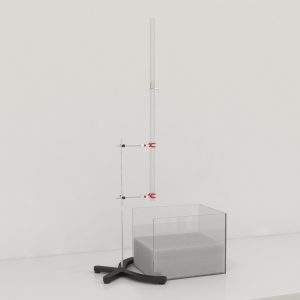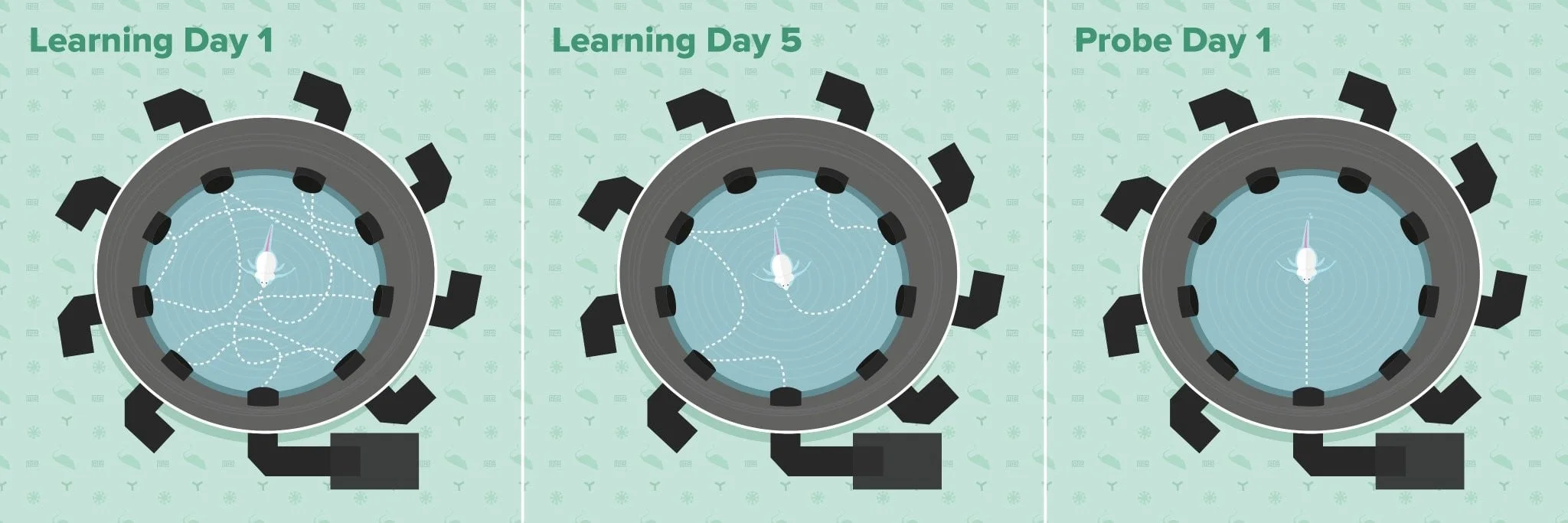$1,390.00 – $1,590.00Price range: $1,390.00 through $1,590.00
The Radial Water Tread Maze modification by MazeEngineers builds upon the foundation of the Morris Water Maze (MWM).
In our adaptation, the maze features nine exits, each elevated 1.5 inches above the floor of the apparatus. Among these exits, eight culminate after a mere 1 inch, serving as decoys to challenge spatial cognition.
A single heated safety box is included, featuring a 90-degree angle to eliminate visual pre-escape cues. For cost efficiency, this box is available for separate purchase and can be obtained A-la-carte.
Upon request, visual cues can be incorporated into the maze to facilitate spatial navigation. The primary objective of the apparatus is to motivate rodents to access a food reward and warmth within the designated goal box. To stimulate escape behavior, experimenters typically fill the tub with one inch of cold water (12–14°C).

MazeEngineers empowers preclinical neuroscience research with meticulously designed, customizable behavioral apparatuses. From manual classic mazes to fully automated smart systems, we provide the tools scientists need to capture high-quality, reproducible data for studies on learning, memory, anxiety, and depression.


bool(false)


Research into cognitive decline in humans, stemming from factors like aging, traumatic brain injury, and neurocognitive disorders, has greatly benefited from the use of rodent models in scientific inquiry. While swimming-based cognitive assessment methods like the Morris Water Maze (Morris, 1984) remain prevalent in evaluating memory impairment and spatial cognition, they pose methodological challenges such as potential motor function impairment and stress-induced confounding variables. Addressing these concerns, the Radial Water Tread Maze (RWT) (Cline et al., 2017; Pettan-Brewer et al., 2013) offers an alternative to the conventional forced-swim paradigm, alleviating the physical demands associated with cognitive evaluation.
Within the RWT maze configuration, water depth is maintained at a shallow level, yet made aversive through measures like cold temperatures or bright lighting to incentivize escape (Cline et al., 2017; Pettan-Brewer et al., 2013). Nine holes are strategically positioned around the tub at uniform intervals, while five distinct visual cues adorn the apparatus’s periphery. Only one of these apertures leads to a safety box, while the remainder act as decoy exits. Rodents are trained to navigate shallow waters and locate the solitary exit, utilizing the visual stimuli as guiding cues. By minimizing physical strain during cognitive tasks, this less physically demanding assessment method effectively mitigates potential influences of post-surgery sensorimotor alterations or deficits observed in rodents.
Constructed from an MWM tub, the radial water tread maze incorporates nine elevated holes positioned around the enclosure, each raised 1 and ½ inches above the apparatus floor. Among these, eight serve as decoy exits, culminating after a mere one-inch trajectory. Conversely, one hole leads to a safety box equipped with a heating pad and food as positive reinforcements. The escape route and decoy exits alike feature passageways bent at a 90-degree angle, thwarting direct visual identification of the correct hole.
The enclosure is adorned with five distinct visual images, serving as spatial cues to facilitate the animal’s navigation. The tub is filled with an inch of water, and depending on the experimental protocol, it is either chilled to 12 to 14 degrees Celsius (Cline et al., 2017) or illuminated by a bright overhead light (Pettan-Brewer et al., 2013) acting as the aversive stimulus.
During the learning trials, the initial training regimen immerses the subject into the radial water tread maze, positioning it at the center and granting it 180 seconds to locate the escape tunnel in each trial. Upon successfully reaching the correct exit, the subject is rewarded with food and permitted to remain in the safety box for 60 seconds. In instances where the mouse fails to discover the proper exit, it is manually guided to the safety box, and a latency time of 180 seconds is recorded for that trial.
If a subject enters a decoy exit and fails to voluntarily re-enter the maze within 5 seconds, it is returned to the center of the maze. Should a subject consistently struggle to complete the task within the 180-second timeframe over any two-day period, it is deemed insufficiently motivated and excluded from further analysis. Throughout the four-day acquisition period, subjects undergo three trials per day.
Probe trials are conducted on day 5 (following the acquisition period) and day 12 (one week after the acquisition period), comprising a short-term memory test and long-term memory test, respectively, each comprising three trials. Latency time is meticulously documented for every trial, with the aid of video tracking systems such as the Noldus Ethovision XT, which facilitate the tracing of the subject’s path.

The sample data is represented through plotting the latency time spent searching for the escape tunnel in each trial of both short-term and long-term memory tests conducted on day 5 and day 12, respectively. Analysis of the graph reveals that lesioned or TBI (traumatic brain injury) subjects exhibited prolonged durations in reaching the correct exit. The notably impaired performance of TBI mice in comparison to the control group strongly indicates cognitive deficits in spatial cognition and memory.
Given the documented motor alterations subsequent to controlled cortical impact (CCI)-induced traumatic brain injury (Cline et al., 2017), there arises a pressing need for the development of a cognitive assessment paradigm capable of mitigating physical strain on rodents, such as the radial water tread maze. The RWT maze effectively mitigates the risk of stress-induced test failure (Cline et al., 2017) by maintaining a shallow water depth of one inch, thereby alleviating the necessity for subjects to swim extensively and reducing distress levels. Furthermore, the current paradigm adeptly leverages rodents’ innate tendency to avoid open spaces and explore the periphery of an apparatus, a phenomenon known as thigmotaxis, in the evaluation of cognitive function.
However, it is important to acknowledge several limitations inherent to the RWT maze. For instance, the use of cold water as an aversive stimulus in water maze setups may introduce the potential confound of hypothermia, necessitating the collection of additional temperature data for each rodent both before and after trials. Additionally, there remains a possibility of some rodents exhibiting insufficient motivation under the testing conditions, leading to nonparticipation in the testing protocol. These factors underscore the need for meticulous consideration and monitoring during experimental design and execution.
Cline, M. M., Yumul, J. C., Hysa, L., Murra, D., Garwin, G. G., Cook, D. G., … & Cross, D. J. (2017). Novel application of a Radial Water Tread maze can distinguish cognitive deficits in mice with traumatic brain injury. Brain research, 1657, 140-147.
Morris, R. (1984). Developments of a water-maze procedure for studying spatial learning in the rat. Journal of neuroscience methods, 11(1), 47-60.
Pettan-Brewer, C., Touch, D. V., Wiley, J. C., Hopkins, H. C., Rabinovitch, P. S., & Ladiges, W. C. (2013). A novel radial water tread maze tracks age-related cognitive decline in mice. Pathobiology of Aging & Age-related Diseases, 3(1), 20679.
| Feet Tub | 4 Feet, 5 Feet, 6 Feet |
|---|
There are no questions yet. Be the first to ask a question about this product.